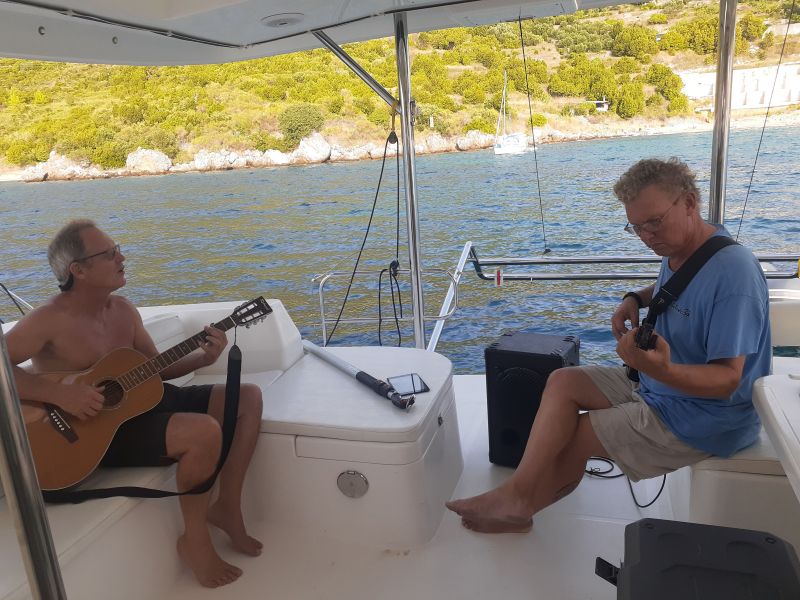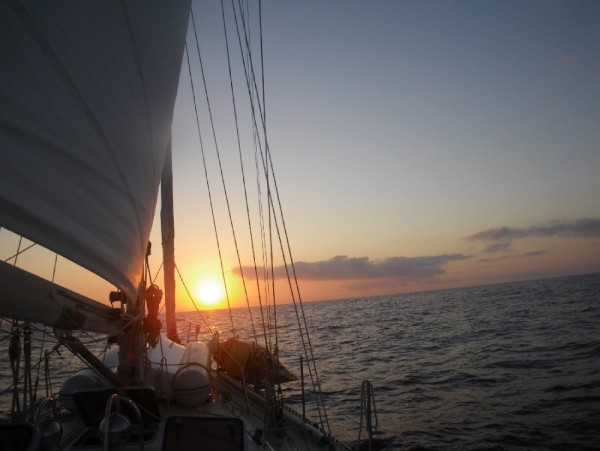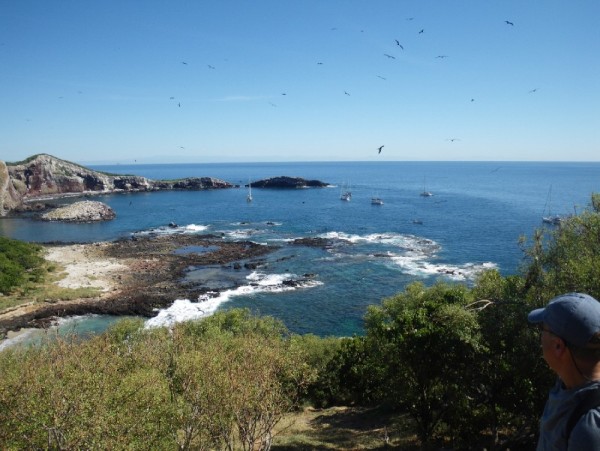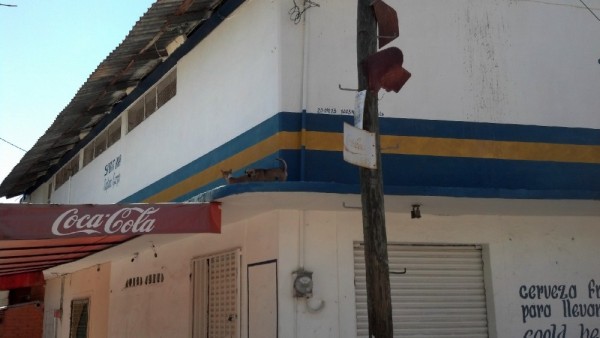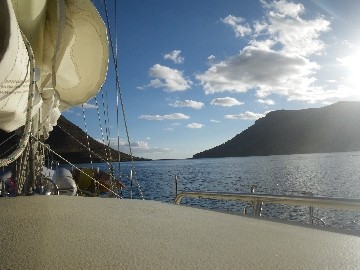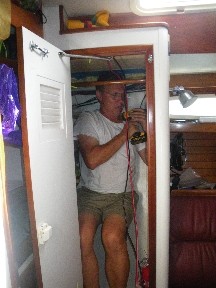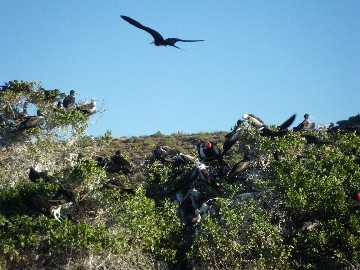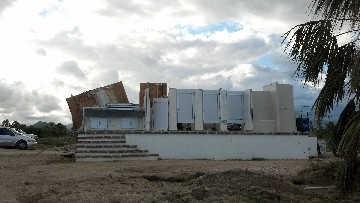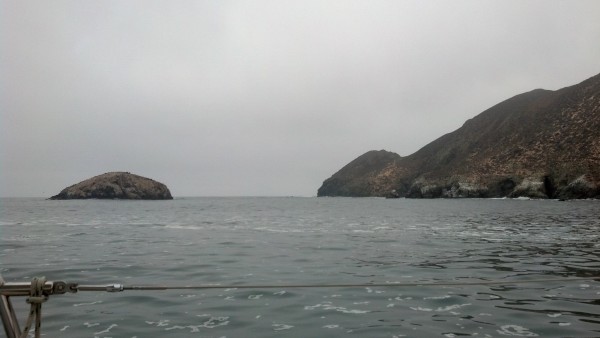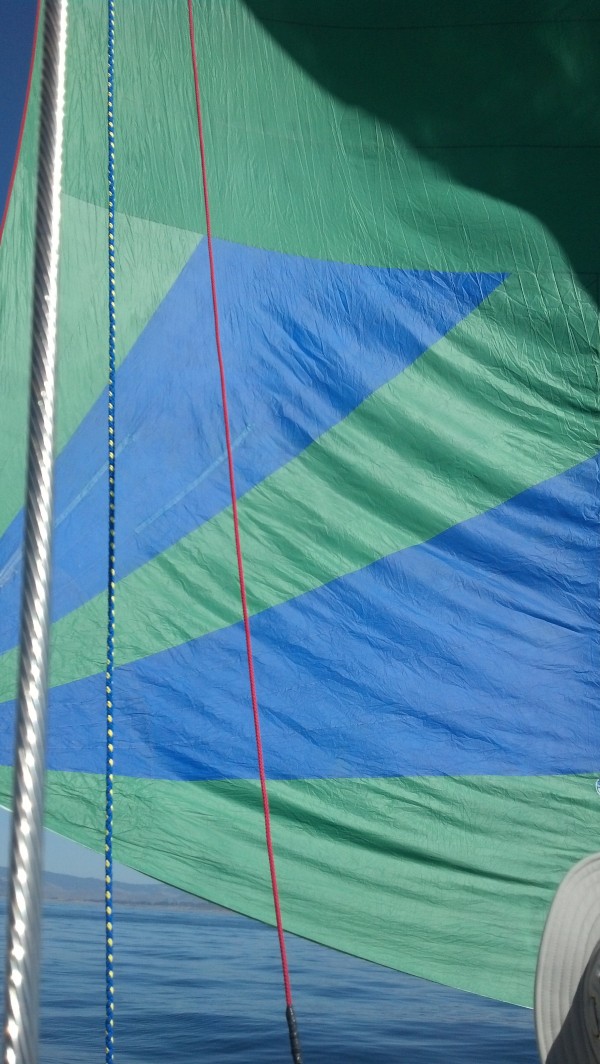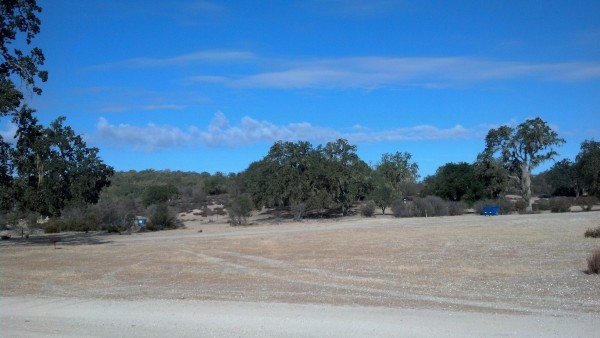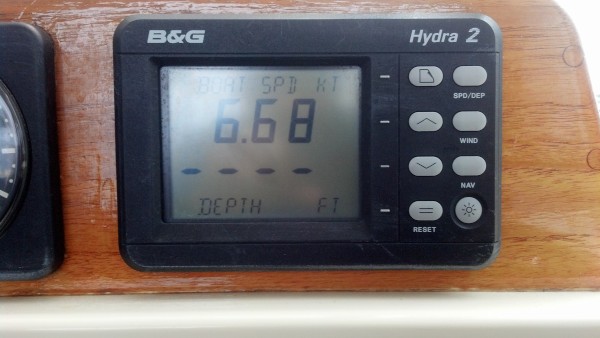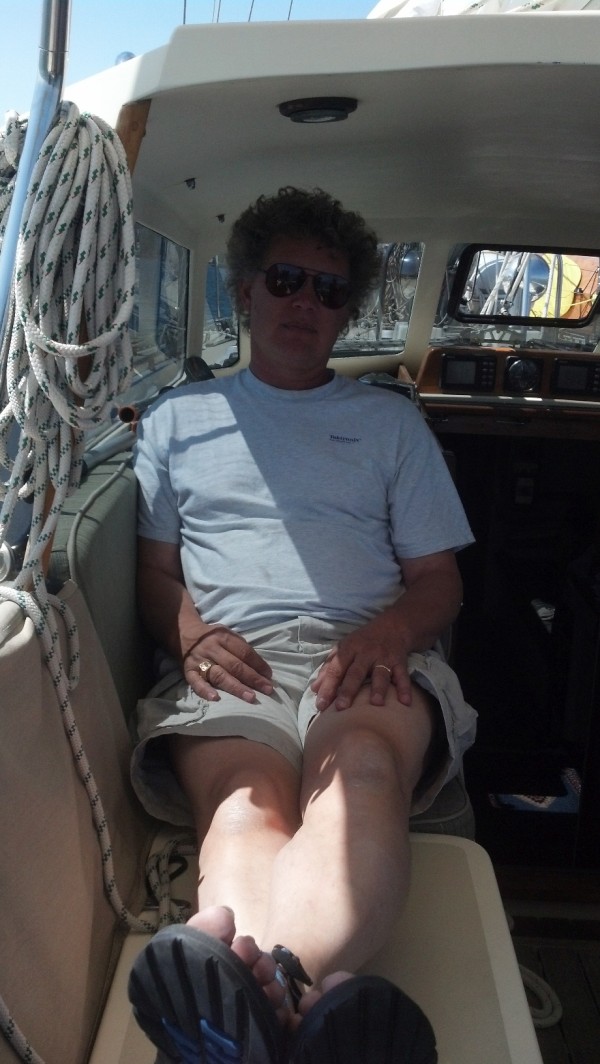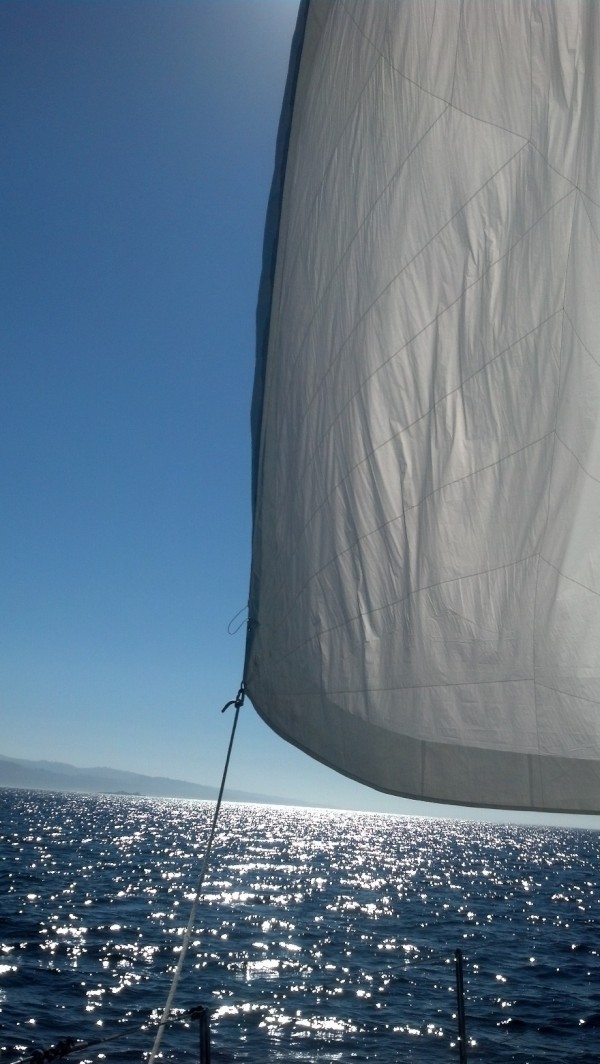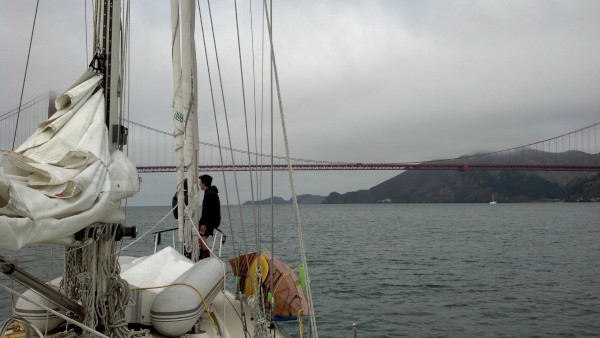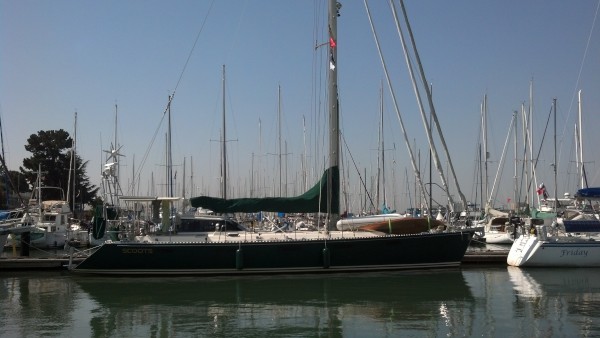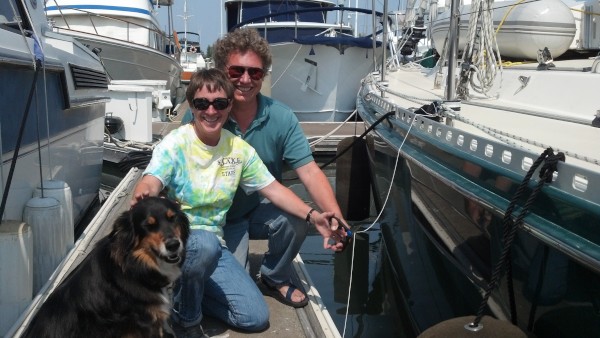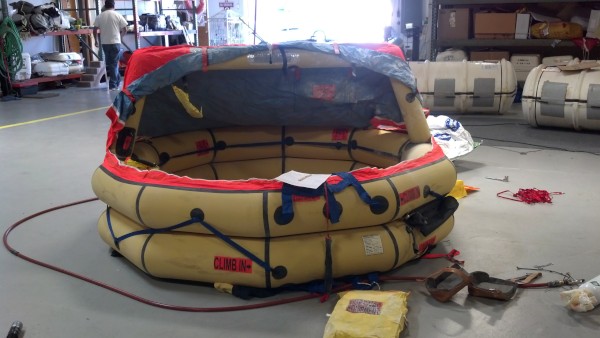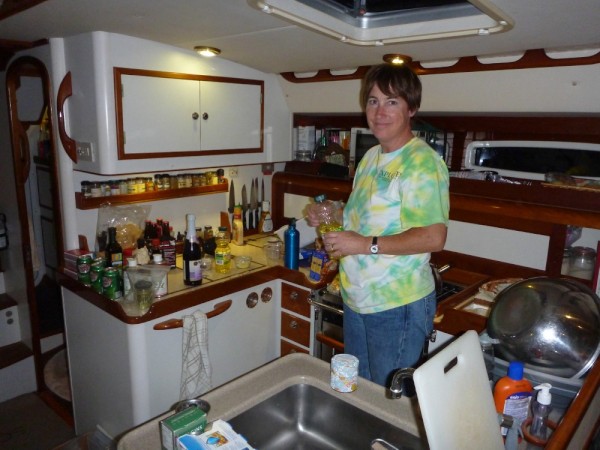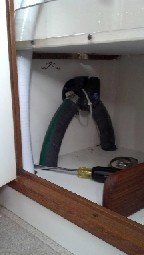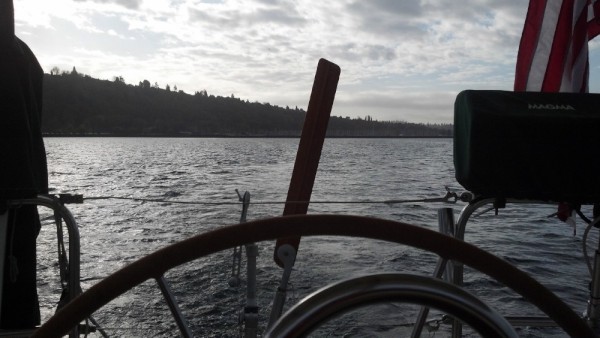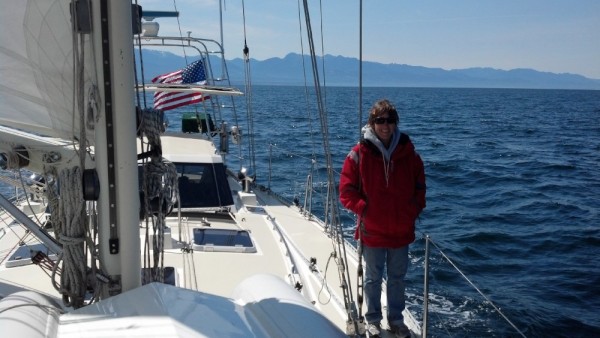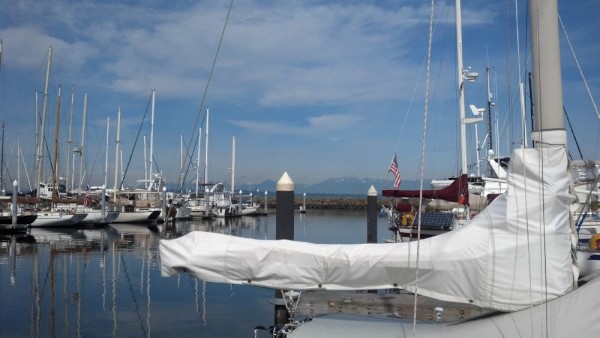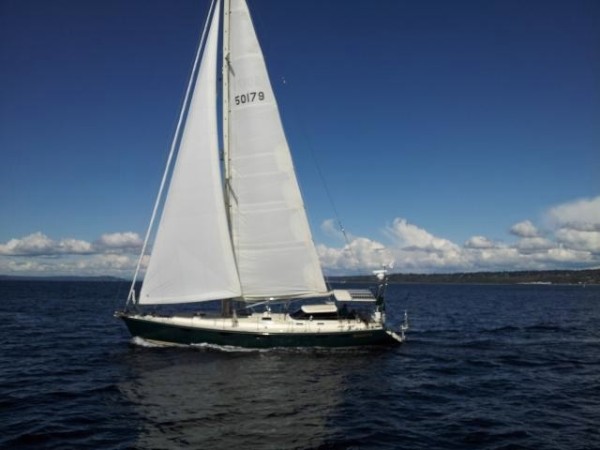
Our Ever-Changing Backyard
14 April 2024 | Zakinthos to Sounion, Greece
27 January 2024 | Preveza to Zakinthos Island, Greece
15 December 2023 | Sarandë, Albania to Preveza, Greece
27 November 2023 | Himarë, Albania
13 November 2023 | Orikum, Albania
30 October 2023 | Durrës, Albania
29 October 2023 | Porto Montenegro to Athens, Greece
22 August 2023 | Montenegro
21 August 2023 | Montenegro
08 August 2023 | Montenegro
02 August 2023
27 July 2023 | Montenegro
04 May 2023
18 April 2023 | Monopoli, Italy - Zadar, Croatia
09 April 2023 | Korčula, Croatia
01 April 2023 | Otok Badija, near Korcula, Croatia
15 March 2023 | Mljet National Park, Croatia
11 December 2022 | Uvala Przina, Pelješac Peninsula, Croatia
20 November 2022 | Uvala Podškolj, Croatia
05 November 2022 | Lopud, Croatia
A day in Dubrovnik: in which we ride a cable car to the top of a mountain, take a tour of a really old town, and have a surprise meeting with a friend
09 October 2022 | Dubrovnik, Croatia
Vandy Shrader
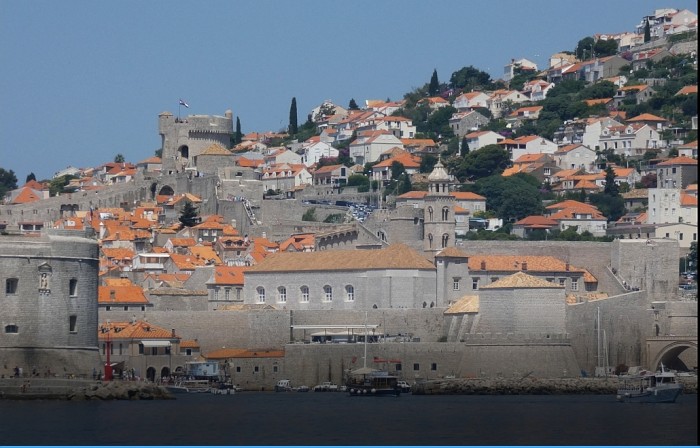
One morning we got up early and took our dinghy into Cavtat, tied it up near Ivan's Restaurant, and walked the short distance to the bus terminal. We bought tickets to Dubrovnik - 25 kuna or about $3.50 each - and settled into our seats. We enjoyed the half-hour trip, mostly along the coast. The sea - blue and sparkling in the morning sun - lay to our left. On our right, dry, rocky, rolling hills stretched away into the eastern distance. At one point on our trip, a couple of women crossed themselves. I wondered whether the next bit of road was particularly treacherous, or whether they were honoring someone who had died nearby. I was hoping for the latter.
We got off the bus at the "cable car" stop, and after looking around for a way to cross the busy highway, discovered the pedestrian underpass made for that purpose. Safely on the other side of the road, it was a ten minute walk downhill to Dubrovnik's Old Town. Wandering through a warren of narrow stone walkways, and down several stone staircases, we eventually arrived at the "Dubravka 1836" restaurant, where we were to meet our tour guide.
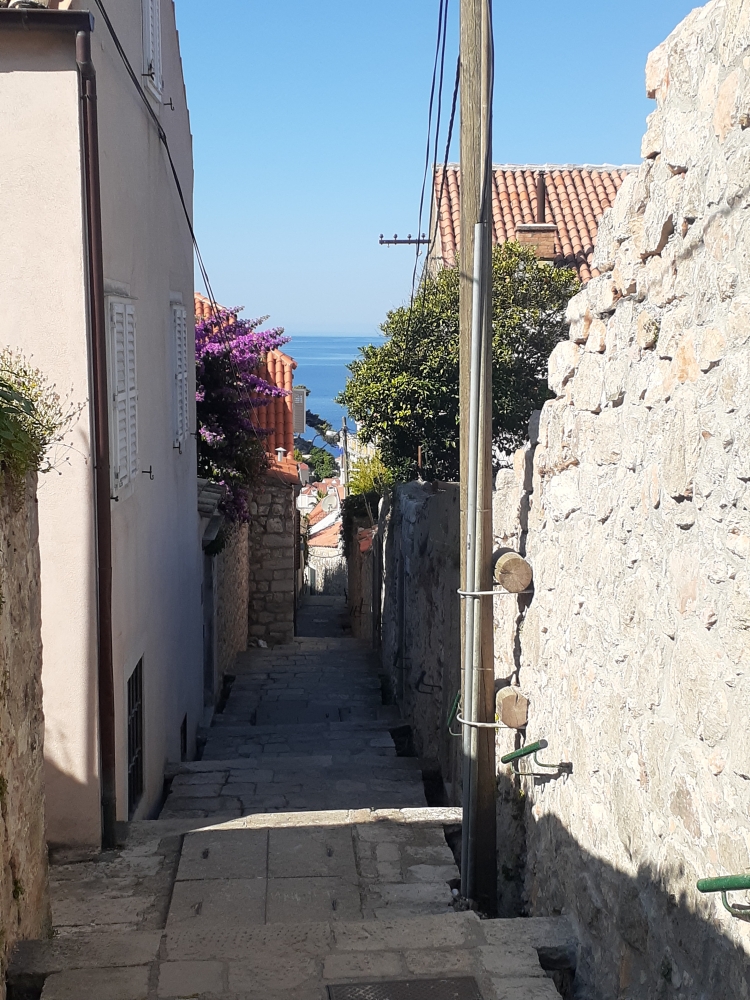
A pretty walkway
Lucia was in her mid-twenties, a native Dubrovnikian who spoke perfect, American-accented English. Later in the tour, Eric asked her where she had learned English with an American accent. She said that she'd watched a lot of American television while growing up.
Our first stop was the lower terminus of Dubrovnik's cable car. Built in the middle of the twentieth century, and then destroyed in the 1990s during what Croatians call the "Homeland War," the cable car circuit was rebuilt by a Swiss company in the early 2000s, becoming fully operational in 2010. As we rode up the side of Mount Srđ behind Dubrovnik, we had spectacular views of the Old Town with its walls, the Adriatic Sea and several nearby islands.
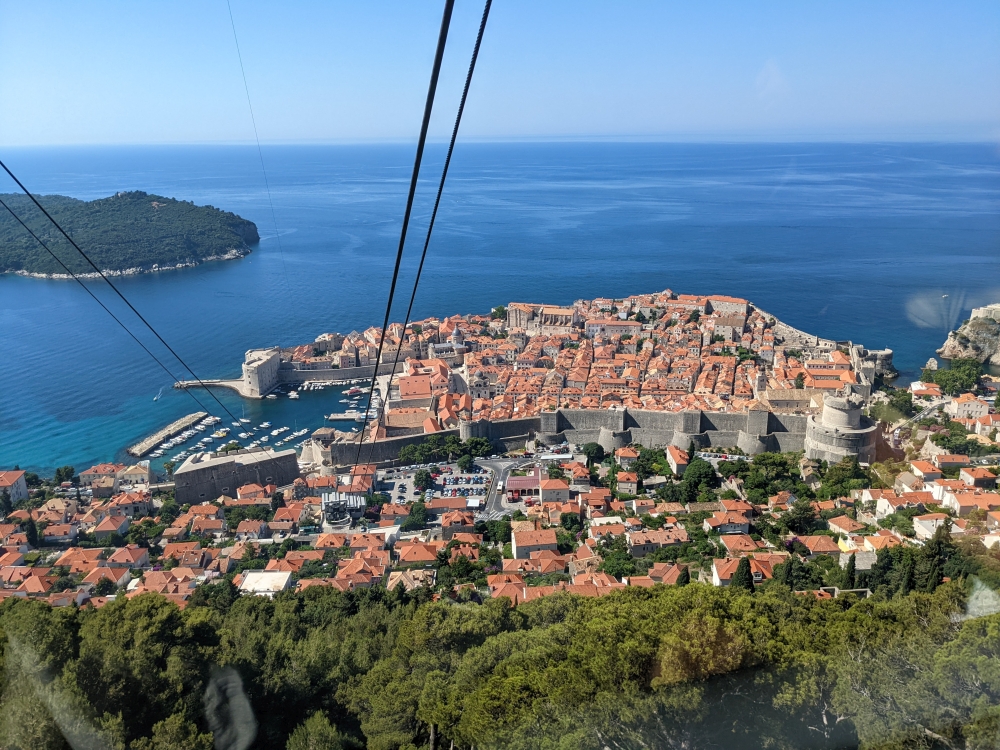
View from the cable car
At the top of the mountain, we were treated to more impressive vistas, and we explored the outside of Fort Imperial.

The view looking north from Fort Imperial
Fort Imperial was built in the early 1800s to defend the eastern (land) side of Dubrovnik, and it came in handy on December 6, 1991. Early on that morning, the Yugoslav People's Army (JNA) attacked the fort, as well as Old Town Dubrovnik, a UNESCO site, killing civilians and destroying many buildings, provoking condemnation from the international community. Dubrovnik was successfully defended on that day by 163 soldiers, who halted the JNA's advance, one of the turning points of the war. The fort houses the Homeland War Museum, which we weren't able to visit that day, since we were on a tour.
Back down in the cable car, we walked through one of Dubrovnik's original city gates and began our tour of the Old Town. As we walked, often shoulder to shoulder with the passengers from a couple of cruise ships, Lucia showed us some of Dubrovnik's many ornate cathedrals and churches, informing us several times that "Croatia always has been and always will be Catholic."
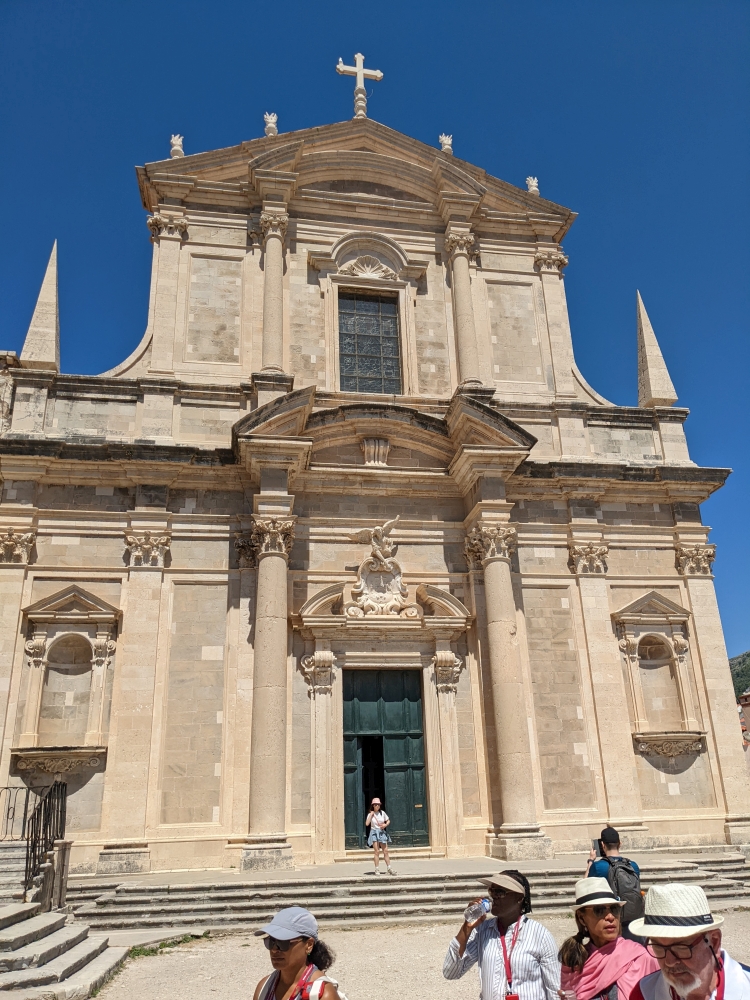
"Always has been and always will be..."
She shared the history of many of the buildings, and took us to a pretty little square that had some fragrant Aleppo pines in whose shade cats napped and pigeons pecked, and high above, twittering swifts sliced through the air like jet fighters. The town was full of pigeons, who lived in the Old Town alongside the humans. Like Croatian Catholicism, they probably "always have been and always will be."
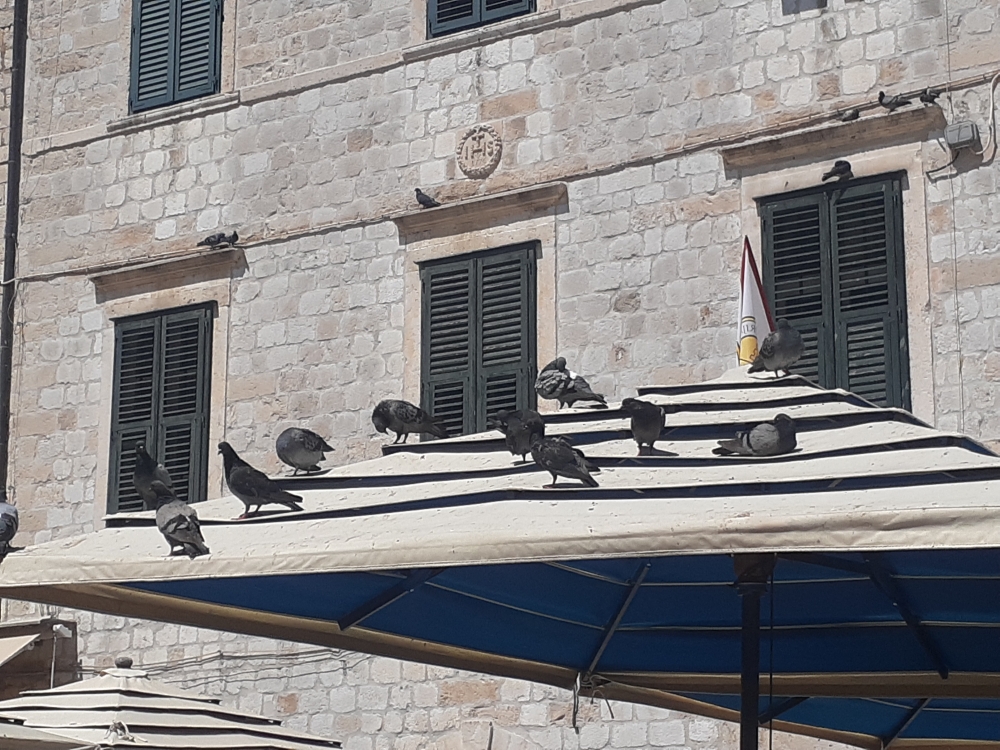
Restaurant pigeons
Dubrovnik has had a very busy history, having been occupied or governed by a revolving door of nations since its inception.
- Back in the dark mists of ancient times, it was home to the Illyrians (including the "Delmati"
tribe, from which the term "Dalmatia" is derived; Dalmatia is the name for the region that encompasses the Croatian coast).
- The Ostrogoths (late 5th century - 537 A.D.)
- Eastern Roman (Byzantine) Empire (537 A.D. - 1205)
- Republic of Venice (1205 - 1358)
- Autonomous Republic of Ragusa (1358-1808) During this period, the government of Dubrovnik instituted what were very enlightened policies for the time: they established a medical system, opened a pharmacy in 1317 (which is still in operation today), built shelters for the elderly and for orphans, had a hospital dedicated to isolating people who were suffering from infectious diseases, abolished the slave trade, and constructed a 20km-long water supply system which was in continuous use until the middle of the 20th century, and whose outlet (the Onofrio fountain) is still operating.
As an interesting aside, when it was discovered that some of the city's residents were boring holes into the aqueduct and channeling the water into their own homes, a law was instituted that made it illegal to do this; offenders would lose their right arm. I imagine that solved the problem.
Lucia told us that April 6,1667 was a really bad day for Dubrovnik. At about 8 am, the city was rocked by a big earthquake, which destroyed most of its buildings and killed more than 5,000 people. The resulting tsunami swamped the port and the coastal areas, and sank all the ships. Then a fire burned in the city for 20 days.
- France (1808-1815)
- Austria (1815-1918)
- Becomes part of the new nation of Yugoslavia (1918-1991)
- Becomes part of the breakaway nation of Croatia (1991-present)
Okay, enough history. Back to the tour.
We filled our water bottles at the Onofrio fountain, whose many outlets still provide cool, clean water four centuries after it was built to provide the residents of Dubrovnik with a reliable water supply.
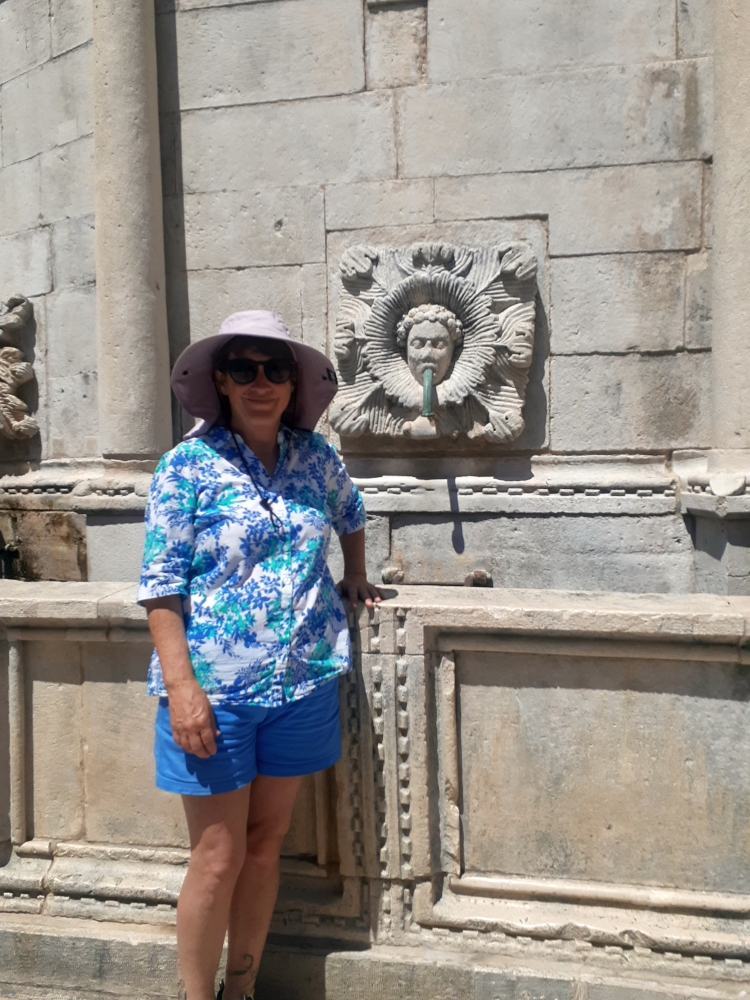
Van at the Onofrio Fountain
We strolled along Stradun, Dubrovnik's wide main street, an expansive boulevard lined with outdoor restaurants, ice cream vendors, and souvenir shops.
Speaking of souvenirs, the multitude of Game of Thrones-themed souvenir shops tipped us off that some of the series had been filmed in Dubrovnik. Apparently, Cersei took her walk of shame down the stairs and through the streets of Old Town Dubrovnik, accompanied by jeering townspeople and enhanced by CGI. Neither of us knew that, being probably the only people on the planet who haven't seen the series. Fans can even book a Game of Thrones-themed tour of Dubrovnik.
We visited the famous Bard Bar, with its cliff-top terrace on the outside of the city walls, accessed from inside the city walls through a passageway. The view of the rocky shoreline and the shining sea from the terrace are spectacular.
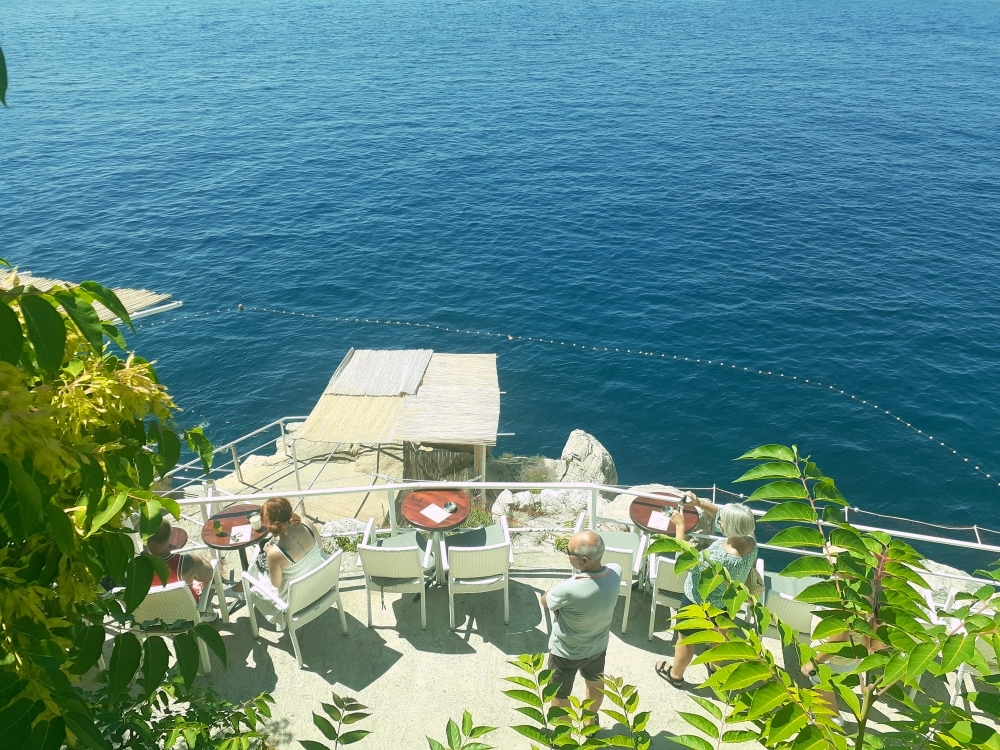
Bard Bar Terrace
When our tour ended, Eric and I decided to walk back through the Old Town, looking for the pizza restaurant that Lucia had recommended. The narrow streets were packed with people. As we were walking, we heard someone shout, "Eric!"
Eric and I didn't expect that he was the Eric being called, because we didn't know anybody in Dubrovnik, or in all of Croatia, for that matter. But it turns out that we were wrong. We turned around and saw a smiling face that we both recognized...it was our cruising friend, Josè!
We'd met Josè back in 2015 when we were all living on our boats in Mexico. Eric and I were on SCOOTS and Josè's boat was named Carthago. We sailed across the Pacific within a few weeks of each other, crossing paths in French Polynesia, and later in New Zealand and Fiji. We'd last seen Josè in Fiji in 2019.
After big smiles and bigger hugs, and "what the heck are you doing here?!"s, we found a little pizza restaurant, where we, Josè, and his friend, Joao, sat down to enjoy some pizza and beer, and a lot of catching up.

Jose, Van, and Eric
Josè and Joao had just finished a few weeks working as skipper and crew for one of the Dubrovnik-based charter boat fleets, and would be leaving Croatia the next day. He'd just happened to see us moving along the crowded street. You never know when - or where - you'll meet one of your cruising friends!
After lunch, we all got ice creams at Peppino's, one of Dubrovnik's finest gelaterias, and then said our "see you later"s, because odds are we probably will.
Eric and I walked the short distance to Fort Lovrijenac. Situated on an outcropping just outside of the city walls, Fort Lovrijenac was built during the 11th century to defend Dubrovnik from the Venetians.
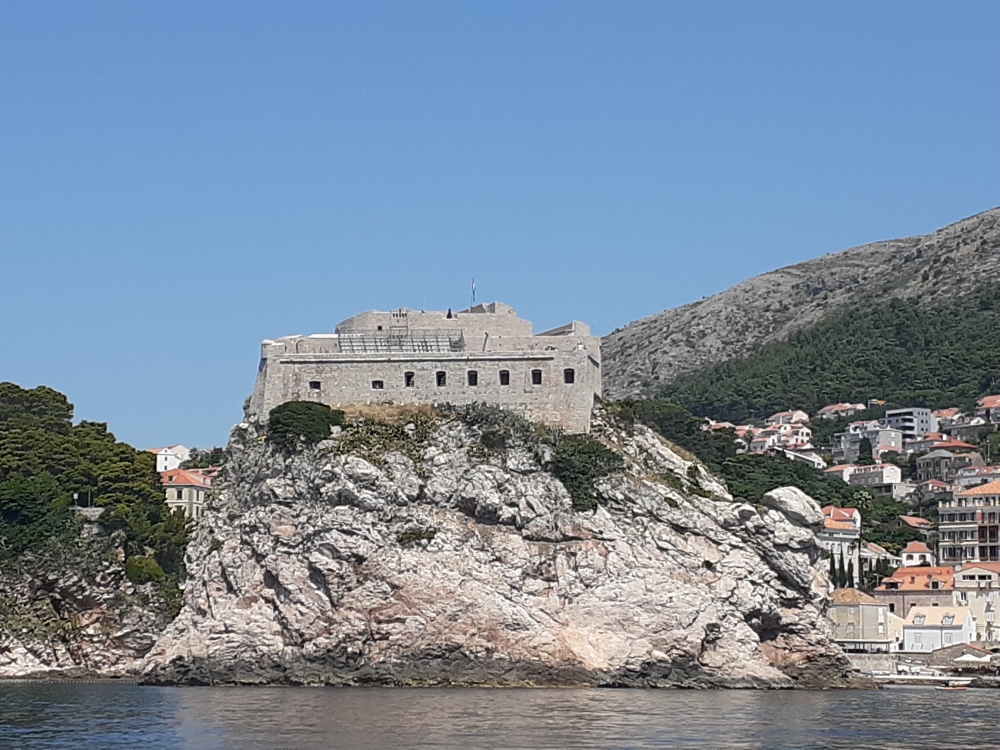
We walked through the rooms and climbed up onto the ramparts of the fort, happily breaking with our European tradition of only being able to see the outside of fortresses.
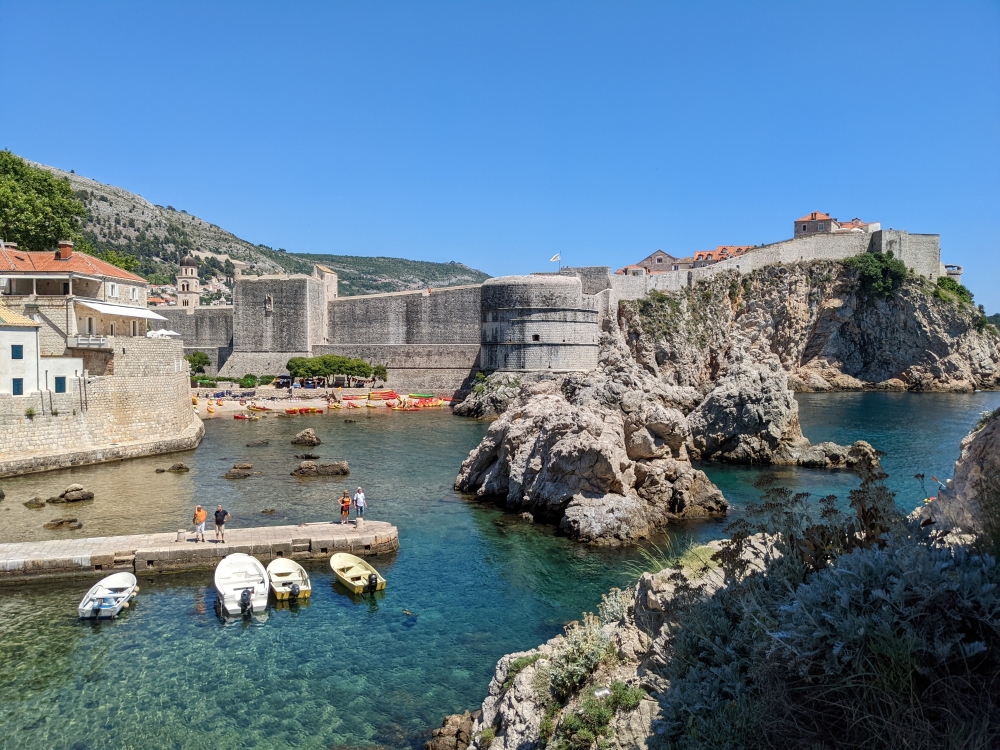
A pretty nice spot for a kayak concession (tucked into the little beach)
These days, the Venetians are pretty docile, and the fort is used for the production of plays.
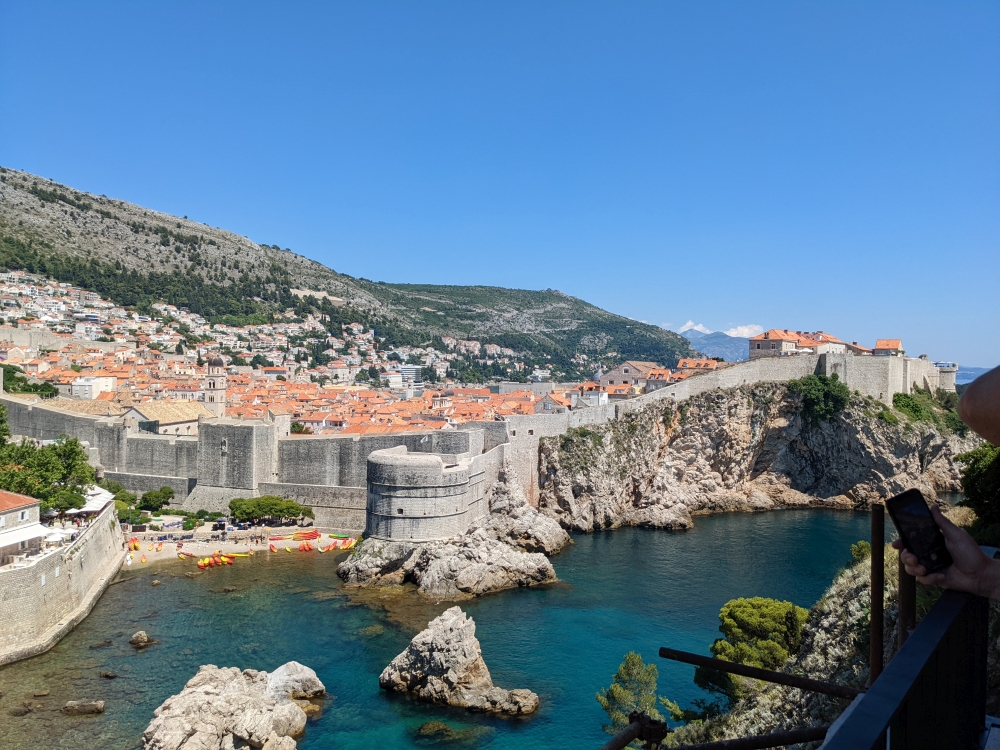
A view toward Old Town Dubrovnik from the Fort
After touring the fort, we were ready to find the bus stop and return to Cavtat. That turned out to take a bit longer than we expected. We had gotten off the bus next to three highway lanes all going north, with no southbound lanes in sight. We weren't sure where to catch the bus going in the other direction. After what seemed like hours (but was probably more like 30 minutes) of ferreting along narrow walkways, plodding up and down stairways, and tramping along the edges of roads, both of us grumpy and sweaty in the oppressive summer heat, we finally found the correct bus stop and sat down to wait for our ride to appear. Which it did after a little while, shuttling us back along the coast (some passengers crossed themselves at the same piece of road as on our northbound trip) to Cavtat, where we retrieved our dinghy, zipped across the bay to Awildian, stripped down to our skivvies, and jumped in the water to cool off. We were done with history and sightseeing and crowds, ready to relax with a cold gin and tonic and play some cards.
We got off the bus at the "cable car" stop, and after looking around for a way to cross the busy highway, discovered the pedestrian underpass made for that purpose. Safely on the other side of the road, it was a ten minute walk downhill to Dubrovnik's Old Town. Wandering through a warren of narrow stone walkways, and down several stone staircases, we eventually arrived at the "Dubravka 1836" restaurant, where we were to meet our tour guide.

A pretty walkway
Lucia was in her mid-twenties, a native Dubrovnikian who spoke perfect, American-accented English. Later in the tour, Eric asked her where she had learned English with an American accent. She said that she'd watched a lot of American television while growing up.
Our first stop was the lower terminus of Dubrovnik's cable car. Built in the middle of the twentieth century, and then destroyed in the 1990s during what Croatians call the "Homeland War," the cable car circuit was rebuilt by a Swiss company in the early 2000s, becoming fully operational in 2010. As we rode up the side of Mount Srđ behind Dubrovnik, we had spectacular views of the Old Town with its walls, the Adriatic Sea and several nearby islands.

View from the cable car
At the top of the mountain, we were treated to more impressive vistas, and we explored the outside of Fort Imperial.

The view looking north from Fort Imperial
Fort Imperial was built in the early 1800s to defend the eastern (land) side of Dubrovnik, and it came in handy on December 6, 1991. Early on that morning, the Yugoslav People's Army (JNA) attacked the fort, as well as Old Town Dubrovnik, a UNESCO site, killing civilians and destroying many buildings, provoking condemnation from the international community. Dubrovnik was successfully defended on that day by 163 soldiers, who halted the JNA's advance, one of the turning points of the war. The fort houses the Homeland War Museum, which we weren't able to visit that day, since we were on a tour.
Back down in the cable car, we walked through one of Dubrovnik's original city gates and began our tour of the Old Town. As we walked, often shoulder to shoulder with the passengers from a couple of cruise ships, Lucia showed us some of Dubrovnik's many ornate cathedrals and churches, informing us several times that "Croatia always has been and always will be Catholic."

"Always has been and always will be..."
She shared the history of many of the buildings, and took us to a pretty little square that had some fragrant Aleppo pines in whose shade cats napped and pigeons pecked, and high above, twittering swifts sliced through the air like jet fighters. The town was full of pigeons, who lived in the Old Town alongside the humans. Like Croatian Catholicism, they probably "always have been and always will be."

Restaurant pigeons
Dubrovnik has had a very busy history, having been occupied or governed by a revolving door of nations since its inception.
- Back in the dark mists of ancient times, it was home to the Illyrians (including the "Delmati"
tribe, from which the term "Dalmatia" is derived; Dalmatia is the name for the region that encompasses the Croatian coast).
- The Ostrogoths (late 5th century - 537 A.D.)
- Eastern Roman (Byzantine) Empire (537 A.D. - 1205)
- Republic of Venice (1205 - 1358)
- Autonomous Republic of Ragusa (1358-1808) During this period, the government of Dubrovnik instituted what were very enlightened policies for the time: they established a medical system, opened a pharmacy in 1317 (which is still in operation today), built shelters for the elderly and for orphans, had a hospital dedicated to isolating people who were suffering from infectious diseases, abolished the slave trade, and constructed a 20km-long water supply system which was in continuous use until the middle of the 20th century, and whose outlet (the Onofrio fountain) is still operating.
As an interesting aside, when it was discovered that some of the city's residents were boring holes into the aqueduct and channeling the water into their own homes, a law was instituted that made it illegal to do this; offenders would lose their right arm. I imagine that solved the problem.
Lucia told us that April 6,1667 was a really bad day for Dubrovnik. At about 8 am, the city was rocked by a big earthquake, which destroyed most of its buildings and killed more than 5,000 people. The resulting tsunami swamped the port and the coastal areas, and sank all the ships. Then a fire burned in the city for 20 days.
- France (1808-1815)
- Austria (1815-1918)
- Becomes part of the new nation of Yugoslavia (1918-1991)
- Becomes part of the breakaway nation of Croatia (1991-present)
Okay, enough history. Back to the tour.
We filled our water bottles at the Onofrio fountain, whose many outlets still provide cool, clean water four centuries after it was built to provide the residents of Dubrovnik with a reliable water supply.

Van at the Onofrio Fountain
We strolled along Stradun, Dubrovnik's wide main street, an expansive boulevard lined with outdoor restaurants, ice cream vendors, and souvenir shops.
Speaking of souvenirs, the multitude of Game of Thrones-themed souvenir shops tipped us off that some of the series had been filmed in Dubrovnik. Apparently, Cersei took her walk of shame down the stairs and through the streets of Old Town Dubrovnik, accompanied by jeering townspeople and enhanced by CGI. Neither of us knew that, being probably the only people on the planet who haven't seen the series. Fans can even book a Game of Thrones-themed tour of Dubrovnik.
We visited the famous Bard Bar, with its cliff-top terrace on the outside of the city walls, accessed from inside the city walls through a passageway. The view of the rocky shoreline and the shining sea from the terrace are spectacular.

Bard Bar Terrace
When our tour ended, Eric and I decided to walk back through the Old Town, looking for the pizza restaurant that Lucia had recommended. The narrow streets were packed with people. As we were walking, we heard someone shout, "Eric!"
Eric and I didn't expect that he was the Eric being called, because we didn't know anybody in Dubrovnik, or in all of Croatia, for that matter. But it turns out that we were wrong. We turned around and saw a smiling face that we both recognized...it was our cruising friend, Josè!
We'd met Josè back in 2015 when we were all living on our boats in Mexico. Eric and I were on SCOOTS and Josè's boat was named Carthago. We sailed across the Pacific within a few weeks of each other, crossing paths in French Polynesia, and later in New Zealand and Fiji. We'd last seen Josè in Fiji in 2019.
After big smiles and bigger hugs, and "what the heck are you doing here?!"s, we found a little pizza restaurant, where we, Josè, and his friend, Joao, sat down to enjoy some pizza and beer, and a lot of catching up.

Jose, Van, and Eric
Josè and Joao had just finished a few weeks working as skipper and crew for one of the Dubrovnik-based charter boat fleets, and would be leaving Croatia the next day. He'd just happened to see us moving along the crowded street. You never know when - or where - you'll meet one of your cruising friends!
After lunch, we all got ice creams at Peppino's, one of Dubrovnik's finest gelaterias, and then said our "see you later"s, because odds are we probably will.
Eric and I walked the short distance to Fort Lovrijenac. Situated on an outcropping just outside of the city walls, Fort Lovrijenac was built during the 11th century to defend Dubrovnik from the Venetians.

We walked through the rooms and climbed up onto the ramparts of the fort, happily breaking with our European tradition of only being able to see the outside of fortresses.

A pretty nice spot for a kayak concession (tucked into the little beach)
These days, the Venetians are pretty docile, and the fort is used for the production of plays.

A view toward Old Town Dubrovnik from the Fort
After touring the fort, we were ready to find the bus stop and return to Cavtat. That turned out to take a bit longer than we expected. We had gotten off the bus next to three highway lanes all going north, with no southbound lanes in sight. We weren't sure where to catch the bus going in the other direction. After what seemed like hours (but was probably more like 30 minutes) of ferreting along narrow walkways, plodding up and down stairways, and tramping along the edges of roads, both of us grumpy and sweaty in the oppressive summer heat, we finally found the correct bus stop and sat down to wait for our ride to appear. Which it did after a little while, shuttling us back along the coast (some passengers crossed themselves at the same piece of road as on our northbound trip) to Cavtat, where we retrieved our dinghy, zipped across the bay to Awildian, stripped down to our skivvies, and jumped in the water to cool off. We were done with history and sightseeing and crowds, ready to relax with a cold gin and tonic and play some cards.
Comments
| Vessel Name: | Awildian, previously SCOOTS (2012-2021) |
| Vessel Make/Model: | Leopard 48 |
| Hailing Port: | San Francisco, CA |
| Crew: | Eric and Vandy Shrader |
| About: | We've been living aboard full time since September 2014. We sailed our Able Apogee 50, SCOOTS, from 2012-2021, and are now aboard our Leopard 48, Awildian, since March 2022. |
| Social: |
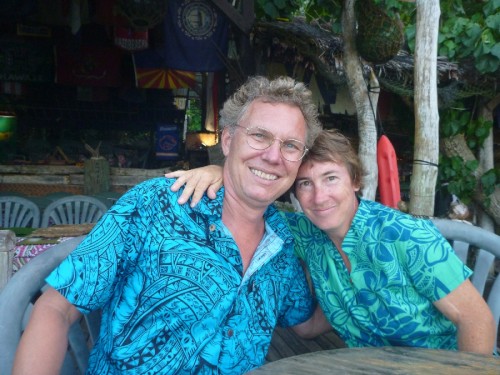
Who: Eric and Vandy Shrader
Port: San Francisco, CA


